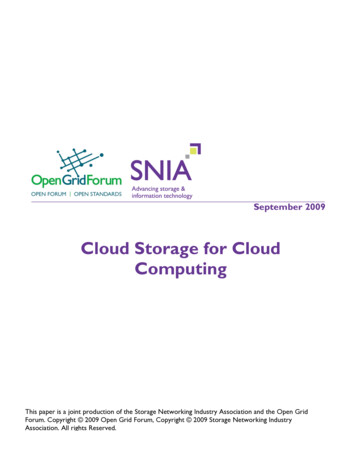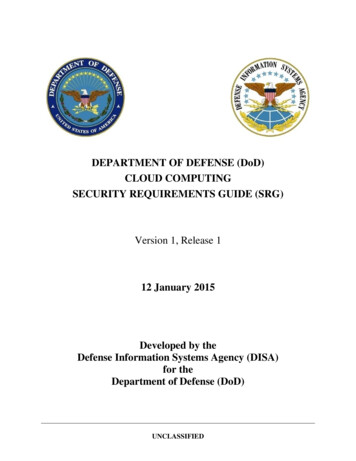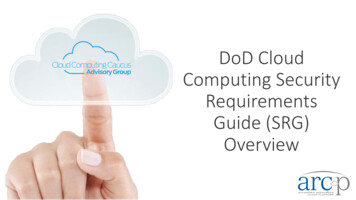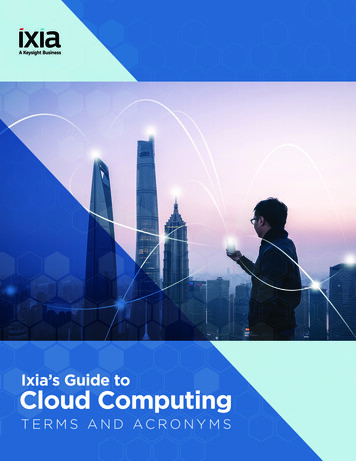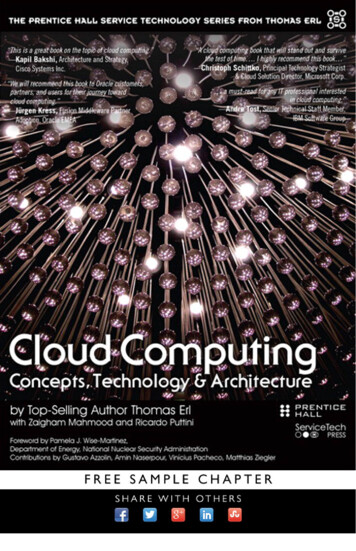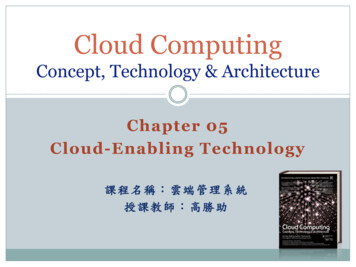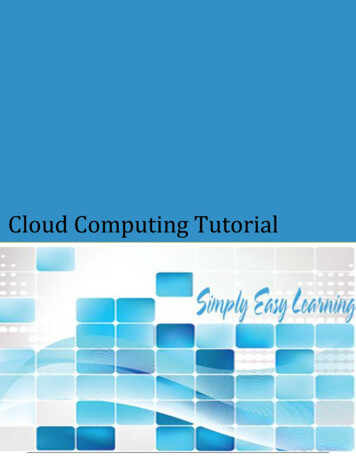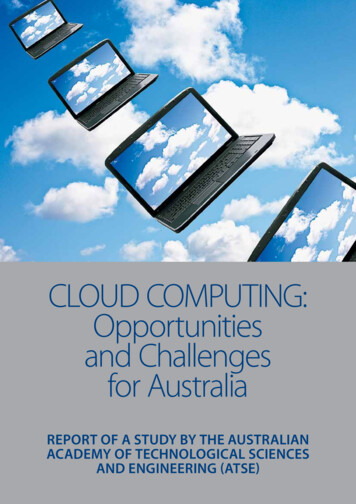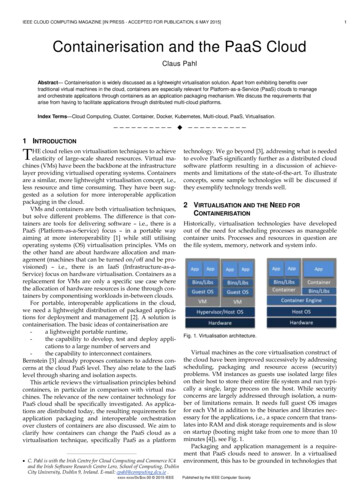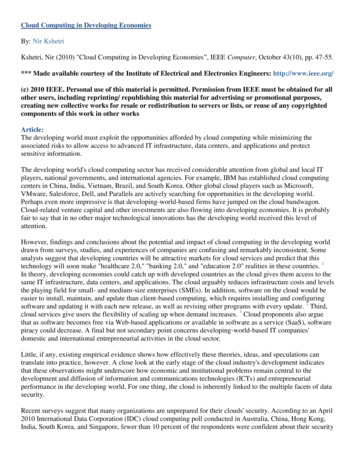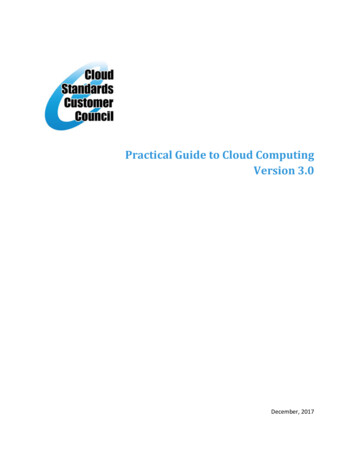
Transcription
Practical Guide to Cloud ComputingVersion 3.0December, 2017
ContentsAcknowledgements3Revisions3Executive Overview5Rationale for Cloud Computing6Essential Characteristics of Cloud Computing6The Benefits of Cloud Computing7What is the Importance of Standards-Based Cloud Computing?8Roadmap for Cloud ComputingStep 1: Assemble your Team for cloud adoption99Step 2: Develop a Business Case and an Enterprise Cloud Strategy12Step 3: Select Cloud Deployment Model(s)16Step 4: Select Cloud Service Model(s)21Step 5: Determine Who Will Develop, Test, Deploy and Maintain the Cloud Services29Step 6: Develop Governance Policies and Service Agreements31Step 7: Assess and Resolve Security, Privacy and Data Residency Issues33Step 8: Integrate with Existing Enterprise Systems37Step 9: Develop a Proof-of-Concept before Moving to Production38Step 10: Manage the Cloud Environment40Summary of Keys to Success41Works Cited43Additional References44Copyright 2017 Cloud Standards Customer CouncilPage 2
2017 Cloud Standards Customer Council.All rights reserved. You may download, store, display on your computer, view, print, and link to thePractical Guide to Cloud Computing at the Cloud Standards Customer Council Web site subject to thefollowing: (a) the Guidance may be used solely for your personal, informational, non-commercial use; (b)the Guidance may not be modified or altered in any way; (c) the Guidance may not be redistributed; and(d) the trademark, copyright or other notices may not be removed. You may quote portions of theGuidance as permitted by the Fair Use provisions of the United States Copyright Act, provided that youattribute the portions to the Cloud Standards Customer Council Practical Guide to Cloud ComputingVersion 3.0 (2017).AcknowledgementsThe Practical Guide to Cloud Computing is a collaborative effort that brings together diverse customerfocused experiences and perspectives into a single guide for IT and business leaders who are consideringcloud adoption. The following participants provided their expertise and time to this Guide and/or itsVersion updates:Anita Ali (TD Bank), Claude Baudoin (cébé IT & Knowledge Management), Jeff Boleman (IBM), AsherBond (Elastic Provisioner), Christian Boudal (IBM), Mike Edwards (IBM), Melvin Greer (Intel), Larry Hofer(Cloud and Security Services), Reddy Karri (Schlumberger), Rajesh Jaluka (IBM), Yves Le Roux (CATechnologies), John McDonald (ClearObject), John Meegan (IBM), Jem Pagan (JNK Securities), Bill Parker(FusionStorm), Sujatha Perepa (IBM), Keith Prabhu (Confidis), Gladwin Rao (IBM), Ram Ravashankar(IBM), Karolyn Schalk (IBM), Prasad Siddabathuni (Independent), Gurpreet Singh (Ekartha), WalterStochevski (UTC-dX), Joe Talik (Neoris), Joel Thimsen (Perficient), Bill Van Order (Lockheed Martin), AmyWohl (Wohl Associates), Elizabeth Woodward (IBM), Steven Woodward (Cloud Perspectives).RevisionsMuch has changed in the realm of cloud computing since the Practical Guide to Cloud Computing,Version 2.0 whitepaper was published in April, 2014. Version 3.0 includes the following updates: The Essential Characteristics of Cloud Computing has been revised to reflect the characteristicsdefined in ISO/IEC 17788.The Select Cloud Deployment Model(s) step has been rewritten.The Determine Who Will Develop, Test, Deploy and Maintain the Cloud Services step has beenexpanded to include considerations for maintaining cloud services.The Assess and Resolve Security, Privacy and Data Residency Issues step has been expanded toinclude the treatment of data residency management.The Develop a Proof-of-Concept before Moving to Production step has been revised to includedefined success criteria.All other sections have been updated to reflect the evolution and maturity of both the businessand technical aspects of cloud computing.Copyright 2017 Cloud Standards Customer CouncilPage 3
References have been added to several new CSCC whitepapers and other supporting industrydocumentation or standards.Copyright 2017 Cloud Standards Customer CouncilPage 4
Executive OverviewThe aim of this guide is to provide a practical reference to help enterprise information technology (IT)and business decision makers adopt cloud computing to solve business challenges. The Practical Guideto Cloud Computing provides comprehensive and actionable information in a single reference.The cloud computing marketplace has evolved in the three years since we published Version 2.0 of thisguide. Cloud computing has moved from an interesting experiment to a proven information technologywith multiple vendors, large and small, taking a variety of approaches. Most customers have adopted atleast some cloud computing technology; others are using cloud computing as their sole IT infrastructureor are moving in that direction.There is considerable interest, governance, and support for cloud computing from formal ITdepartments, but there continues to be a presence of Line of Business (LOB) managers spending their ITbudgets on cloud services, often without the knowledge or approval of IT management [1]. Also, largenumbers of business customers are still choosing their own cloud technologies and expecting IT tosupport and manage them after the procurement decisions have been made.This guide provides a way of evaluating the market from the point of view of your organization’s needsand providing information that is helpful in selecting both a cloud architecture and an implementationapproach through the use of in-house staff, cloud vendor(s) or both.From an architectural perspective, we have moved beyond the simple alternatives of private vs. publicclouds. Hybrid clouds (including multiple clouds, both private and public, temporarily or permanentlyinterconnected) are commonplace.Today, it is expected that an organization may have any or all of these models, depending on its needsfor speed of execution, available resources, various levels of data protection and security, centralizedmanagement and an array of other reasons. A discussion of how to choose the most effective cloudservice and deployment model is included in this guide.Another area of rapid development relates to the building of “cloud native” applications and to thetechnologies and architectures that have evolved to support them. The use of containers, “serverless”computing, and microservices architecture are becoming commonplace. It is necessary to factor in theseaspects of cloud computing into decisions as to which cloud services to use.The “Roadmap for Cloud Computing” section is the heart of the guide. It details both strategic andtactical activities for decision makers implementing cloud solutions. It also provides specific guidance todecision makers on the selection of cloud service and deployment models. The activities andrecommendations in the roadmap take into account the different sizes and IT maturity of customerorganizations.Despite the guidelines provided in this whitepaper, the ultimate selection of cloud solutions and theirsuccess depend upon the judgement of IT and business decision makers and their organizational andoperational realities.Copyright 2017 Cloud Standards Customer CouncilPage 5
Rationale for Cloud ComputingCloud computing offers a value proposition that is different from traditional enterprise IT environments.By providing a way to exploit technologies such as virtualization, application containers, and serverlesscomputing which aggregate and share computing resources, cloud computing can offer economies ofscale that would otherwise be unavailable. With minimal upfront investment, cloud computing enablesglobal reach of services and information through an elastic utility computing environment that supportson-demand scalability. Cloud computing can also offer pre-built solutions and services, backed by theskills necessary to run and maintain them, potentially lowering risk and removing the need for theorganization to retain a group of scarce highly-skilled staff.Cloud computing does not exist in a vacuum. Most organizations have a broad variety of applicationsalready running in their data center. For most, cloud computing will extend their existing ITinfrastructure. Cloud computing can be dedicated to particular tasks. It can be used mainly for newprojects or an organization may use it for surge demand, guaranteeing a certain level of performance forenterprise computing.Essential Characteristics of Cloud Computing Broad network access: A feature where the physical and virtual resources are available over anetwork and accessed through standard mechanisms that promote use by heterogeneous clientplatforms. The focus of this key characteristic is that cloud computing offers an increased levelof convenience in that users can access physical and virtual resources from wherever they needto work, as long as it is network accessible, using a wide variety of clients including devices suchas mobile phones, tablets, laptops, and workstations; Measured service: A feature where the metered delivery of cloud services is such that usage canbe monitored, controlled, reported, and billed. This is an important feature needed to optimizeand validate the delivered cloud service. The focus of this key characteristic is that the customermay only pay for the resources that they use. From the customer's perspective, cloud computingoffers the users value by enabling a switch from a low efficiency and asset utilization businessmodel to a high efficiency one; Multi-tenancy: A feature where physical or virtual resources are allocated in such a way thatmultiple tenants and their computations and data are isolated from and inaccessible to oneanother. Typically, and within the context of multi-tenancy, the group of cloud service users thatform a tenant will all belong to the same cloud service customer organization. There might becases where the group of cloud service users involves users from multiple different cloud servicecustomers, particularly in the case of public cloud and community cloud deployments. However,a given cloud service customer organization might have many different tenancies with a singlecloud service provider representing different groups within the organization;Copyright 2017 Cloud Standards Customer CouncilPage 6
On-demand self-service: A feature where a cloud service customer can provision computingcapabilities, as needed, automatically or with minimal interaction with the cloud serviceprovider. The focus of this key characteristic is that cloud computing offers users a relativereduction in costs, time, and effort needed to take an action, since it grants the user the abilityto do what they need, when they need it, without requiring additional human user interactionsor overhead; Rapid elasticity and scalability: A feature where physical or virtual resources can be rapidly andelastically adjusted, in some cases automatically, to quickly increase or decrease resources. Forthe cloud service customer, the physical or virtual resources available for provisioning oftenappear to be unlimited and can be purchased in any quantity at any time automatically, subjectto constraints of service agreements. Therefore, the focus of this key characteristic is that cloudcomputing means that the customers no longer need to worry about limited resources andmight not need to worry about capacity planning; Resource pooling: A feature where a cloud service provider's physical or virtual resources can beaggregated in order to serve one or more cloud service customers. The focus of this keycharacteristic is that cloud service providers can support multi-tenancy while at the same timeusing abstraction to mask the complexity of the process from the customer. From thecustomer's perspective, all they know is that the service works, while they generally have nocontrol or knowledge over how the resources are being provided or where the resources arelocated. This offloads some of the customer's original workload, such as maintenancerequirements, to the provider. Even with this level of abstraction, it should be pointed out thatusers might still be able to specify location at a higher level of abstraction (e.g., country, state,or data center).Refer to the ISO/IEC 17788 standard [2] for more details on cloud computing characteristics, roles,deployment models and service models.The Benefits of Cloud ComputingIn addition to providing access to a shared pool of configurable computing resources (e.g., networks,servers and storage), cloud computing promotes a loosely coupled, composable and highly reusableservices environment for agile application development and roll-out. Because virtual instances andsupporting services can be provisioned and terminated at any time and the customer organization paysonly for the computing resource they are employing, costs can be lower, and they are paid “as you go,”not as an upfront capital expenditure.Cloud computing enables business agility. Cloud computing provides the ability to make use ofcomputing resources on an immediate basis, rather than a need to first invest time and skilled resourcesin designing and implementing infrastructure (hardware and middleware) and/or applications, and thendeploying and testing it. This leads to faster time to value which may mean greater revenue, largermarket share, or other benefits.Copyright 2017 Cloud Standards Customer CouncilPage 7
In essence, the top six benefits of cloud computing can be summarized as follows:1. Achieve economies of scale. Increase volume output or productivity with fewer resources(computing and human).2. Reduce CapEx by moving to OpEx. The “pay as you go” operational expenditure (OpEx) model,based on demand / utility computing, will help reduce capital expenditure (CapEx) on hardwareand software licenses.3. Improve access. Information access can be anytime, anywhere and anyhow through omnichannel access.4. Implement agile development at low cost. Design, development and rollout of new solutions andservices using agile methodologies on cloud-based shared development operations.5. Leverage the global workforce. A “follow-the-sun” model can provide 24x7 resources fordefining, developing and rolling out new solutions. Cloud computing can be rolled out inmultiple data centers around the globe, ensuring that services are close to end users – providingbetter performance, customer service, and appropriate redundancy.6. Gain access to advanced capabilities. Many of the latest advances in software (such as AI,Blockchain, Data Mining) are available off-the-shelf as cloud services, enabling an organizationto gain the benefits of these capabilities with minimal investment.What is the Importance of Standards-Based Cloud Computing?Standards-based cloud computing ensures that cloud services from multiple providers can readilyinteroperate, based on open standard interfaces. Standards, when appropriately applied, allowworkloads to be readily moved from one cloud provider to a different one with minimum effort.Applications created for one cloud computing environment can be employed in another one, eliminatingthe need to rewrite or duplicate code.Many different standards have been proposed. Some permit various degrees of interoperability andportability, while others are in fact proprietary environments. Once a proprietary environment isselected, an organization will probably experience some degree of vendor lock-in. This means thatintegrating applications or services across differing proprietary cloud platforms is likely to requireexpensive and time-consuming work. The issues associated with lack of interoperability and portabilityare described in ISO/IEC 19941 Cloud computing -- Interoperability and Portability [3].Some of the proposed standards are based on open source initiatives, for example the Open ContainerInitiative [4]. This has the advantage of making all the code transparent, available for inspection, andmore readily suited for an interoperable environment. However, whenever a new technology isattracting a great deal of attention, neither vendors nor customers are likely to wait for maturestandards or rich open source environments. They tend to leverage the advantage of early adoption ofemerging technology at the price of having to move to a standard (and perhaps an open source)environment at a later date.Copyright 2017 Cloud Standards Customer CouncilPage 8
Roadmap for Cloud ComputingThis section provides a prescriptive series of steps that customer should take to ensure a successfulcloud deployment. It takes into account differences in the sizes of organizations and their IT maturitylevels. The following steps are discussed in detail:1.2.3.4.5.6.7.8.9.10.Assemble your team for cloud adoptionDevelop a business case and an enterprise cloud strategySelect cloud deployment model(s)Select cloud service model(s)Determine who will develop, test, deploy and maintain the cloud servicesDevelop governance policies and service agreementsAssess and resolve security, compliance, privacy and data residency issuesIntegrate with existing enterprise servicesDevelop a proof-of-concept (POC) before moving to productionManage the cloud environment. Depending on the maturity of the organization and the level ofadoption of cloud computing, the entry point will change for each new service being evaluated.Step 1: Assemble Your Team for Cloud AdoptionIt is important that the cloud customer 1 establishes a clearly defined team to develop and approve acloud business strategy and implementation plan for cloud services that will be part of the total ITenvironment.Along with cloud computing, an evolution in the partnership between IT and business leaders is drivingmore robust collaborative decision making. In the past, the recommendations, design, development,deployment and maintenance of the IT environment were primarily driven by the IT department. Cloudcomputing is creating an evolution wherein business leaders are getting more closely engaged in ITdecisions. To support this digitalization of the business, the IT decision maker must expand their thinkingin terms of who the key stakeholders are. More and more often you see roles like the Chief MarketingOfficer (CMO), Chief Data or Digital Officer (CDO), or Chief Cloud Officer (CCO) influencing IT budgets.Adoption of cloud services is increasingly viewed as a strategic business decision that allows businessnot only to improve IT efficiency but also help in achievement of global business goals.While requirements around cost, performance, longevity, and feature/functionality roadmap are stillcritical, the modern CIO must also take into consideration input from such key stakeholders as the CEO,CDO, CFO, CISO, CMO, and Development or Product Leadership. The following are some examples ofwhat the C-Suite will be looking for:1Note that this section focuses on the cloud customer. Points of contact between the cloud customers and cloudproviders, brokers, and carriers are covered in the later steps of this section.Copyright 2017 Cloud Standards Customer CouncilPage 9
CEO: Co-driving innovation and differentiation capabilities within the organization enablingthe CEO to focus on growing the business. Cares about finding new ways to differentiatethrough technology.CDO: Mapping digital capabilities to strategic priorities, enabling new functionality orefficiencies, measuring efficiencies and ROI; re-engineering/automation of businessprocesses can improve costs and promote revenue generation. Consolidated monitoring ofdigital initiatives is critical.CFO: Co-driving data privacy, maintenance of financial records, and security of financialreporting systems. Cares about the growth aspect of the finance agenda, while deliveringefficiencies through technology adoption.CISO: Co-driving information management, risk management, brand protection, third-partyrelationship management, and other functions beyond their historically technical role. Caresabout standardization and security being integrated throughout the technology stack; fromphysical through logical; IAM, DLP, IDP/IDS.CMO: Co-driving Digital Transformation. Cares about the customer experience; newcustomer touch points, new opportunities for engagement, and more integratedexperiences.This is happening because the business is increasingly seeing cloud computing as a tool to: Get closer to their customersImprove IT efficiency and Improve product time to marketBalance the financial portfolio (CapEx vs. OpEx)Increase sales/revenueStreamline the supply chainExtend business processes, making them more accessible by third partiesReach new customer segmentsPartner data sharing/integration opportunitiesStandardize the technology stack and related securityLeverage cloud native security capabilitiesBottom line, the adoption of multiple cloud consumption models for infrastructure needs is beingviewed more and more as a strategic business decision. Hence, it is logical that the adoption of cloudcomputing should be led by senior management with a broader section of the C-Suite playing the role ofkey advisors.In essence, the team you build will need to address various aspects of adoption. These resourcesparticipate to different degrees in three phases of cloud adoption described in Figure 1. Different skillsare required at the different phases of cloud adoption—strategic, tactical and operations planning.Copyright 2017 Cloud Standards Customer CouncilPage 10
Figure 1: Three Phases of Cloud AdoptionStrategic Planning PhaseDuring the strategic planning phase of cloud service adoption, CEOs and the senior management teamlead the organization to establish the vision, terms of reference, and guidelines. Vision. The CEO and senior management team should define the overall vision for cloudadoption. It is critical that the business leadership, particularly the executive levels, collaborateand buy in to the vision. The vision should address the future of the business and the acquireddifferentiation, competitive advantage, and/or value proposition gained through a cloudstrategy.Terms of reference. Terms of reference should be defined early to ensure that adoption staysfocused on the target business goals. Effective terms of reference should at minimum addressthe purpose, goals, guiding principles, roles and responsibilities, and rules of engagement of theteams involved in forming the cloud computing vision and strategy.Guidelines. Based on the culture of the business, senior management should provide broadguidelines for cloud adoption, including security and privacy posture, data maintenance andlocation policies, etc. The guidelines will provide a business framework to capture the initialhigh-level requirements, and support the alignment of the leadership team.Workload Planning PhaseDuring the tactical planning phase, typically led by the CIO or CTO, the organization performs both abusiness and a technical analysis. Business analysis. This phase requires the oversight of senior business stakeholders such as theCMO, product or application owners, IT (including as necessary the CIO, CTO, CISO, leadarchitects and business continuity manager), and legal representatives who must review andcommunicate regulatory compliance and legal requirements. The overall goal is to build abusiness case and the supporting long-term enterprise strategy for the transition to cloudcomputing that delivers sufficient return on investment or return on value.It is critical that the business drivers for transformation remain the primary focus during thisphase. Technology comparisons and early calls on the technology solution could negativelyimpact a sound understanding of the business requirements if introduced too early in theprocess.Copyright 2017 Cloud Standards Customer CouncilPage 11
This phase will provide the foundation for categorizing and identifying suitable applications orworkloads to be considered as candidates for implementation in the cloud. Technical analysis. This phase requires the attention of IT (or digital) stakeholders including theCIO, CTO, CDO, CCO, CISO as well as lead architects, operations personnel, IT security, andsenior business managers. The goal of this phase is to develop a Transformation Roadmap whichin addition to the Technology Roadmap would include components such as Critical SuccessFactors, Service Management Capability Maturity Roadmap, Organizational Functional Model, ITArchitectures and Operations Models, Processes and Capabilities, to name a few.On the Technology Roadmap, development of the target consumption models takes the businessrequirements analysis results from this prior phase, and compares it to the various cloud servicesand deployment models that are available. It is during this phase that the business case forapplication or workload migration, as well as application “build versus buy” is developed andpresented to the strategic team for their feedback. Business processes and flows will likely also bedisrupted and impacted. Business processes and flows will likely also be disrupted and impacted innon-technical areas such as procurement and technical areas such as provisioning of services.Operations Planning PhaseDuring the operational implementation phase, leaders from various operations groups work throughprocurement and implementation details, and establish ongoing operational plans and processes for thecloud deployment. Procurement. This phase includes negotiations with potential cloud service providers andrequires the procurement team, finance, legal, senior business managers, and IT including theCIO, CTO and lead architects to be engaged. Assessment models/instruments should bediscussed to provide consistency during the evaluation and contract negotiation phases. Forexample, a proof-of-concept or weighted scoring matrix may be developed to align business andtechnology requirements. Implementation. This phase includes the development, customization, and configuration ofsolutions which will be deployed in the cloud environment and requires the attention of ITincluding lead architects, developers and testers as well as operations personnel. This phaseshould begin the process of identifying potential changes in processes/procedures and provide ahigh-level gap analysis to identify risk mitigation/management opportunities. Operations. This phase addresses ongoing operations and management of the cloud servicesand deployed solutions. Business owners, operations personnel, customer support, and ITincluding developers and testers are required in this phase. During this phase, the gap analysismoves from a high level to a more detailed examination to determine what (and how) changesto existing operations will be impacted by the cloud computing initiative.Copyright 2017 Cloud Standards Customer CouncilPage 12
Step 2: Develop a Business Case and an Enterprise Cloud StrategyTo ensure a smooth transition to cloud computing, an organization should develop an overarching cloudstrategy which creates the foundation for project-specific adoption. Cloud computing presentsinteresting business model opportunities to organizations of all sizes. Developing a business case andstrategy that clearly articulates how cloud computing will transform key business processes likeprocurement, marketing, customer acquisition and support, product development, etc. is critical.Within the context of an enterprise strategy for cloud computing, individual business problems thatcloud computing can potentially address need to be identified, and specific business justification mustshow that cloud computing is the right strategic alternative. High level value propositions for cloudcomputing, including the shift of capital expenditures (CapEx) to operational expenses (OpEx), costsavings, rapid deployment, elasticity, access to advanced capabilities, etc., are necessary but insufficientunless quantified.Obtaining executive support for the initiative is critical. Executives from IT, Lines of Business (LOBs),procurement and executive management must review and approve the business plan beforeproceeding. Getting key executives on-board early in the process will help alleviate potential issuesdown the line.When developing an enterprise strategy for cloud computing, the considerations highlighted in thefollowing table should be taken into account.Table 1: Key Elements of Strategic PlanningElement of Strategic PlanningStrategic Planning ActivitiesEducate the team All team members (IT, business, operations, legal and executives)must be educated on what cloud computing is and what it is not. Establish a common definition of cloud computing (includingterminology) for the entire organization so everyone is speakingthe same language. Using cloud computing is an iterative process in which newservices build on previously implemented services add value toexisting IT environments.Establish both short and long term plans Create an organization-wide master blueprint and roadmap foradoption. Map cloud computing benefits against existing business problemsto identify potential solution areas. Anticipate the variety of disruptions that may occur both insideand especially outside IT (service levels, security, legal, vendormanagement, etc.). Leverage long-term planning to reduce risk of vendor lock-in byconsidering interoperability, portability and ease of integration upfront.Copyright 2017 Cloud Standards Customer CouncilPage 13
Element of Strategic PlanningStrategic Planning ActivitiesUnderstand required services andfunctionality Determine business case and potential ROI and/or potential newrevenue opportunities. Leverage enterprise architectures, standards and industryframeworks to help accelerate the collection of serviceinformation and improve consistency. Customer facing services require separate categorization andanalysis from internal services.Execute a thorough cost analysis [5]The overall cost of application migration
guide. Cloud computing has moved from an interesting experiment to a proven information technology with multiple vendors, large and small, taking a variety of approaches. Most customers have adopted at least some cloud computing technology; others are using cloud computing as thei
